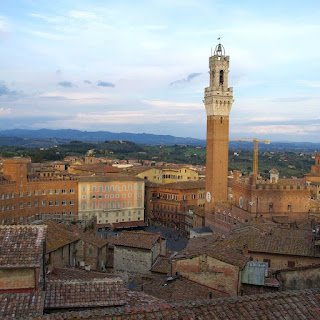Eventually he became a priest and secretary to a bishop, then secretary to the antipope Felix V, then pope himself as Pius II, recounted in this post. What that leaves out was that he used his authority as pope to indulge in some urban planning, designing a "perfect city."
His perfect city started as the town of Corsignano in Siena, his birthplace. It appears in records as early as the 9th century. The Piccolomini family came into possession of parts of it about a century before Enea was born. Holy Roman Emperor Frederick II had given an ancestor, Engelbherto Piccolomini, a fiefdom there in 1220. This is the town he chose to become "Pienza" ("Pius city").
He rebuilt the town over five years into what he considered an ideal Renaissance city, with a cathedral (the building on the left in the illustration), palaces for the family and for the bishop, and a new town hall in a trapezoidal pattern. He intended it as a vacation place from Rome.
The rebuilding was overseen by Bernardo Rossellini (1409–1464), whose design work was enhanced by his skill at assembling a large number of skilled stoneworkers to create a premier workshop in Florence.
Pope Pius was the only pope until that time who had written an autobiography. In 1462 he began an account of his life, including details about the structures of Pienza. This was perhaps unnecessary, because they still stand. (In 1996 Pienza was declared a UNESCO Heritage site.)
This was an early example of urban planning. Are there others? What was the status of urban planning in the Middle Ages? Let's start to answer that question tomorrow.





